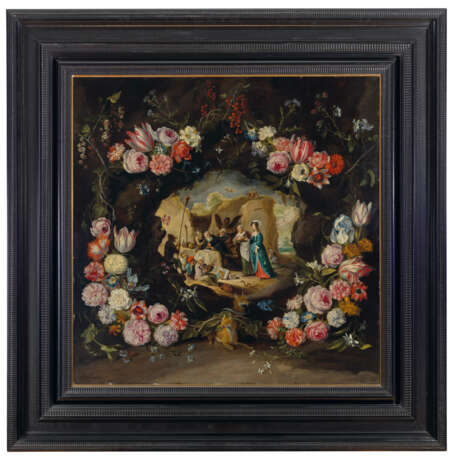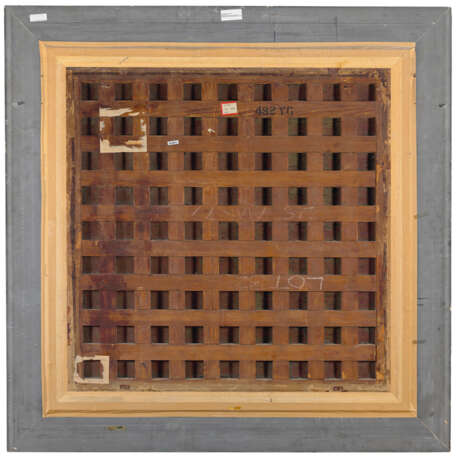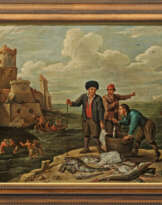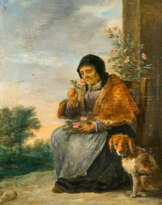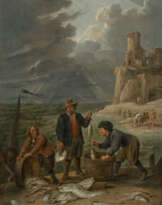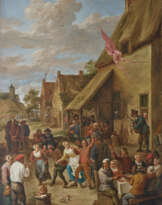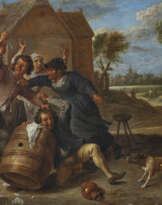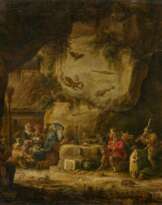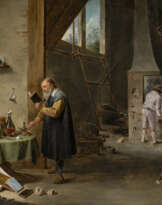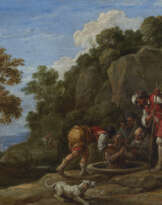ID 1071529
Lot 16 | JAN BRUEGHEL LE JEUNE (BRUXELLES 1601-1678 ANVERS) ET DAVID TENIERS LE JEUNE (ANVERS 1610-1690 BRUXELLES)
Estimate value
€ 250 000 – 350 000
La Tentation de saint Antoine dans une guirlande de fleurs
signé 'i . breughel . F .' (en bas, à gauche)
inscrit 'TODO ES ENGANIO' (sur le phylactère dans la gueule du renard, au centre, en bas)
huile sur cuivre
94,5 x 94 cm. ( 37 3⁄16 x 37 in.)
Provenance
Vente anonyme, Christie's, Londres, 25 mars 1977, lot 32.
Collection particulière, Madrid, depuis 1977.
Literature
K. Ertz, Jan Breughel der Jüngere (1601-1678): die Gemälde, mit kritischem Œuvrekatalog, I, Freren, 1984, p. 477, n°311.
Further Details
JAN BRUEGHEL THE YOUNGER AND DAVID TENIERS THE YOUNGER, THE TEMPTATION OF ST. ANTHONY IN A FLOWER CARTOUCHE, SIGNED, INSCRIBED, OIL ON COPPER
Executed on an impressively large copper sheet, the present painting is the work of two of the most emblematic Flemish artists of the 17th Century, Jan Brueghel the Younger (1601-1678) and David Teniers the Younger (1610-1690).
The first of these, whose signature appears at the bottom of the painting, took up the mantel of his father, Jan Brueghel the Elder (1568-1625), himself the son of the great Pieter Bruegel the Elder (c. 1525/1530-1569), who at the beginning of the 17th Century had conceived of this form of composition, with a garland of flowers or fruit painted against a dark background around a central medallion. This could contain either a religious or profane subject, for the most part executed by a collaborator (M.-L. Hairs, ‘Jean Breughel le Jeune, Peintre de fleurs’, Revue Belge d’Archéologie et d’Histoire de l’Art, XXXVI, 1-4, 1967, p. 64). A wonderful example of such a collaboration can be seen in the Louvre, the Vierge, l'Enfant Jésus et des anges au milieu d'une guirlande de fleurs (inv. no. 1764), where the central scene is the work of Sir Pieter Paul Rubens (1577-1640) and the still life is the work of Jan Brueghel the Elder.
In the present work the central motif is the Temptation of Saint Anthony, a religious scene that Teniers painted on a number of occasions. The Prado and the Rijksmuseum both hold examples of this subject by the Antwerp painter (inv. no. P001822 and inv. no. SK-A-401), though these differ in composition to the scene presented here. A drawing previously in the collection of Emile Wauters (fig. 1) can, however, be seen as a preparatory work for the present painting, though it is still not identical, the main difference being the figure seated at lower left, who is absent from the painting.
The subject of Saint Anthony sits within an important iconographic tradition in European art. The tempting visions of earthly delights that the saint endured in the Egyptian desert seduced a number of painters, whose imaginations were sparked by this passage in the life of the anchorite. One of the most famous of these is the triptych by Hieronymus Bosch (c. 1450-1516), now in the musées royaux des Beaux-Arts in Brussels (inv. no. 3032).
Klaus Ertz, the great specialist in the Brueghel dynasty, dated the present painting to the 1650s (K. Ertz, 1984, op. cit. supra). On the banderol held by the two foxes sitting in the bottom of the garland the Spanish inscription ‘Todo es enganio [sic]’ (All is illusion) can be read – an illusion to the fragility of human life. Analysis of the three horizontal bars on the letter ‘E’ of ‘enganio’ suggests that these were added slightly later on, changing this from an ‘I’ and correcting the original orthographic error. This Spanish flourish suggests that this painting was originally commissioned by a wealthy Spaniard likely living in the Low Countries, which at this date were ruled by the Spanish Hapsburgs.
| Artist: | David Teniers II (1610 - 1690) |
|---|---|
| Applied technique: | Metalwork, Oil, Painted |
| Medium: | Copper |
| Art style: | Old Masters |
| Place of origin: | Belgium, Western Europe, Europe |
| Auction house category: | Paintings |
| Artist: | David Teniers II (1610 - 1690) |
|---|---|
| Applied technique: | Metalwork, Oil, Painted |
| Medium: | Copper |
| Art style: | Old Masters |
| Place of origin: | Belgium, Western Europe, Europe |
| Auction house category: | Paintings |
| Address of auction |
CHRISTIE'S 9 Avenue Matignon 75008 Paris France | ||||||||||||||
|---|---|---|---|---|---|---|---|---|---|---|---|---|---|---|---|
| Preview |
| ||||||||||||||
| Phone | +33 (0)1 40 76 85 85 | ||||||||||||||
| Fax | +33 (0)1 40 76 85 86 | ||||||||||||||
| Conditions of purchase | Conditions of purchase | ||||||||||||||
| Shipping |
Postal service Courier service pickup by yourself | ||||||||||||||
| Payment methods |
Wire Transfer | ||||||||||||||
| Business hours | Business hours
|

